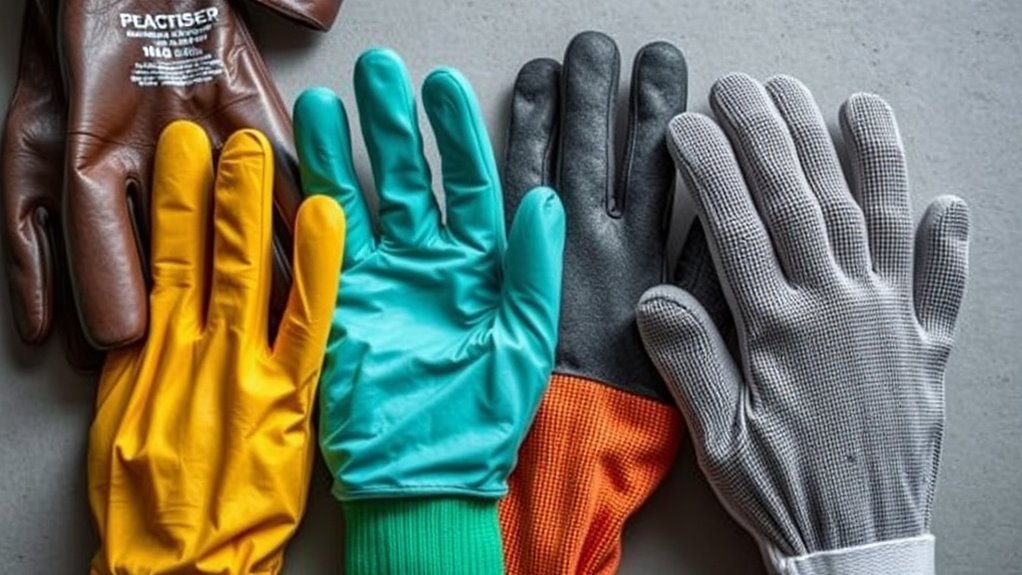How Different Glove Materials Protect Against Hazards

Different glove materials protect you from various hazards in unique ways. Latex gloves provide a good fit and resistance to biological hazards, but they can cause allergies. Nitrile gloves are a strong alternative, offering excellent puncture resistance and chemical protection while being latex-free. Leather gloves guarantee durability, while Kevlar gloves focus on cut and thermal resistance. Each material offers distinct advantages depending on your needs, and there’s much more to discover about their specific applications.
Key Takeaways
- Nitrile gloves offer robust chemical resistance, protecting hands from oils, fats, and various hazardous substances.
- Latex gloves provide excellent fit and protection against chemical and biological hazards but carry a risk of allergic reactions.
- Kevlar gloves ensure high cut and heat resistance, essential for professionals working in hazardous environments like construction or manufacturing.
- Leather gloves combine durability with natural abrasion resistance, making them suitable for rough handling in both work and casual settings.
- Vinyl gloves are lightweight and cost-effective, providing basic protection against non-hazardous situations without the risk of latex allergies.
Overview of Common Glove Materials
When it comes to choosing gloves, understanding the materials involved is essential. Various glove materials serve different purposes and offer varying levels of protection against hazards.
For instance, nitrile gloves provide strong chemical resistance, making them ideal for handling hazardous substances. Meanwhile, vinyl gloves are lightweight and cost-effective but offer less protection against chemicals.
If you’re in a healthcare environment, you might find latex gloves are popular due to their excellent fit and flexibility. However, keep in mind that some individuals may be allergic to latex.
Another option is neoprene, which delivers both chemical and heat protection, catering to a range of industrial applications. Knowing these materials helps you choose the right gloves for your specific needs.
Latex Gloves: Benefits and Limitations

Latex gloves stand out in the world of personal protective equipment for their excellent fit and versatility. They conform to your hands, providing a tactile feel that’s vital for tasks requiring precision. Additionally, they offer good resistance to various chemicals and biological hazards, making them popular in medical and laboratory settings.
However, there are limitations to contemplate. Many people have latex allergies, which can cause reactions ranging from mild irritation to severe anaphylaxis. Also, while they offer decent barrier protection, they’re not as puncture-resistant as some other materials.
If you’re working in an environment where allergens or puncture risks are present, you might want to explore alternatives. Overall, latex gloves are effective, but evaluating your specific needs is essential.
Nitrile Gloves: A Strong Alternative
For those seeking a latex-free option, nitrile gloves provide a strong alternative that meets many of the same demands. These gloves are made from synthetic rubber, offering excellent puncture resistance and durability.
They’re perfect for tasks involving chemicals, oils, and fats, as they stand up to a variety of hazardous substances. If you’re worried about allergies, nitrile gloves minimize the risk of irritations associated with latex, making them a safer choice for sensitive skin.
They also come in various thicknesses, providing options for different levels of protection. Plus, their snug fit guarantees dexterity, allowing you to perform tasks with precision.
When you need a reliable glove that combines strength and comfort, nitrile is definitely worth considering.
Leather Gloves: Durability and Comfort
There’s something to be said for the timeless appeal of leather gloves, which seamlessly combine durability and comfort. When you slip on a pair, you’ll instantly feel the plush texture molding to your hands, providing a snug fit that enhances grip without sacrificing flexibility.
Leather’s natural resistance to wear means these gloves can withstand a lot of rough handling while still looking great.
Moreover, leather offers a breathable quality that keeps your hands comfortable across various temperatures. Whether you’re working outdoors or handling materials in a workshop, you’ll appreciate the protection and dexterity they provide.
Plus, the classic style makes them suitable for both work and casual wear, ensuring you stay protected and stylish at the same time. Additionally, it’s essential to choose leather gloves that meet industry safety gear standards, as these regulations help ensure effective protection in hazardous environments.
Kevlar Gloves: Protection Against Cuts and Heat
When you need reliable protection against cuts and heat, Kevlar gloves are an excellent choice. Made from a synthetic fiber, these gloves provide exceptional cut resistance, making them ideal for tasks like construction, manufacturing, or handling sharp objects. The material’s strength helps keep your hands safe, even in hazardous environments.
Additionally, Kevlar’s heat-resistant properties offer protection against thermal hazards. Whether you’re working near hot surfaces or materials, these gloves can help protect your hands from burns.
They’re designed to be lightweight and flexible, allowing for better dexterity while working. Incorporating Kevlar gloves into your safety gear not only enhances protection but also boosts your confidence in handling potentially dangerous tasks.
They’re a smart investment for any safety-conscious professional.
Questions
Are There Gloves Suitable for Sensitive Skin?
Yes, there are gloves specifically designed for sensitive skin. You’ll want to look for options made from latex-free materials, like nitrile or vinyl, which reduce irritation and provide comfort while still offering necessary protection.
How Do I Choose the Right Glove Size?
Choosing the right glove size is like finding a well-fitted shoe—comfortable yet snug. Measure your hand’s width and length, then consult size charts. Trust your instincts; the right fit guarantees protection and dexterity.
Can Gloves Be Reused or Are They Disposable?
Gloves can be either reusable or disposable, depending on their material and intended use. If you choose reusable gloves, guarantee they’re thoroughly cleaned after each use. Disposable ones are meant for single use only, keeping you safe.
What Is the Lifespan of Different Glove Materials?
The lifespan of different glove materials varies. Latex gloves usually last a few hours, nitrile can last longer, and vinyl may wear out quickly. Always check for signs of wear to guarantee safety during use.
Do Gloves Offer Protection Against Electrical Hazards?
Yes, gloves can protect against electrical hazards, but it’s essential to choose ones specifically designed for that purpose. Always check the voltage rating and material to guarantee you’re safe while working with electricity.
Conclusion
In choosing the right glove material, it’s essential to contemplate the specific hazards you might face. For instance, think about a healthcare worker using nitrile gloves for safe handling of chemicals and bodily fluids. They offer excellent puncture resistance and chemical protection, reducing the risk of exposure. By knowing the strengths of each glove type, you can make informed decisions to keep yourself safe in any situation. So, next time you gear up, think of the protection your hands deserve!






